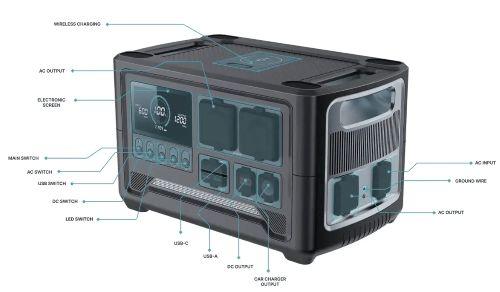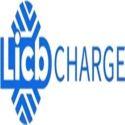Notifications

9 minutes, 29 seconds
-2 Views 0 Comments 0 Likes 0 Reviews

As a premier EV charger manufacturer in China, LiCB Charge delivers dependable AC and DC electric vehicle charging stations along with complete charging solutions.
In today’s always-connected world, reliable access to electricity is more essential than ever. Whether you’re preparing for an unexpected power outage, planning an extended camping trip, or seeking an eco-friendly alternative to gas-powered generators, portable power stations have become an essential tool for households, travelers, and outdoor enthusiasts alike.
But what exactly is a portable power station? How does it work, and what should you look for when choosing one? This comprehensive guide breaks down the technology, key features, benefits, and practical applications of portable power stations—plus how they differ from traditional generators and what the future holds for this growing segment of the energy market.
A portable power station is a compact, rechargeable device that stores electrical energy in an internal battery, allowing you to power or charge electronic devices anytime, anywhere. Unlike traditional gas generators, which are noisy, emit fumes, and require frequent maintenance, portable power stations use clean battery technology to deliver quiet, efficient energy on demand.
Also referred to as battery-powered generators or solar generators (when used with solar panels), these devices typically include:
Battery Pack: The core component that stores energy—commonly lithium-ion or LiFePO₄ (lithium iron phosphate) batteries known for their durability and safety.
Power Inverter: Converts stored DC (direct current) energy into AC (alternating current) for compatibility with household appliances.
Output Ports: A mix of AC outlets, USB-A, USB-C, DC carports, and even wireless charging pads for powering multiple devices simultaneously.
From smartphones and laptops to mini-fridges, CPAP machines, cameras, and even power tools, portable power stations are versatile enough to support both daily needs and critical emergencies.
The operation is simple and user-friendly:
Energy Storage
Charge the unit from a wall socket, vehicle charger, or solar panel.
Power Conversion
The inverter transforms stored DC energy into usable AC power.
Power Delivery
Electricity is delivered through various ports to connected devices, ensuring safe and consistent output.
Some models also support pass-through charging, allowing the unit to power devices while it recharges—a valuable feature during extended use or emergencies.
Modern portable power stations offer several convenient ways to recharge:
Wall Charging (AC): The fastest and easiest method—simply plug into any home outlet.
Car Charging (DC): Use a 12V car outlet to top off your station during road trips.
Solar Charging: Compatible models can connect to solar panels, providing clean, renewable energy wherever sunlight is available—ideal for camping or off-grid living.
Here’s a quick side-by-side comparison:
| Feature | Portable Power Station | Gas Generator |
|---|---|---|
| Power Source | Rechargeable battery, solar input | Gasoline, diesel, or propane |
| Noise Level | Virtually silent | Loud engine noise |
| Emissions | Zero emissions | Produces exhaust fumes |
| Indoor Use | Safe | Not safe (carbon monoxide risk) |
| Maintenance | Minimal | Regular oil/fuel maintenance required |
| Fuel Cost | Free (with solar or charged battery) | Ongoing fuel expenses |
While traditional generators are still used for heavy-duty, long-duration tasks, modern portable power stations offer a cleaner, quieter, and more convenient alternative for most daily and emergency needs.
Perfect for indoor use, camping, or nighttime activities—no engine noise to disrupt the peace.
Battery-powered stations produce no fumes. With solar integration, they become a completely green energy solution.
No risk of carbon monoxide, making them safe for use in enclosed spaces like homes, cabins, or tents.
No oil changes, fuel refills, or moving parts—just keep the battery charged and monitor its status.
Designed for easy transportation. Many units include handles, wheels, or compact form factors.
Recharge via AC, DC, or solar. This versatility allows you to stay powered no matter where you are.
Portable power stations are incredibly adaptable and commonly used for:
Home Backup: Keep essentials like lighting, Wi-Fi, and refrigerators running during outages.
Outdoor Adventures: Power for camping, overlanding, hiking, and RV travel.
Remote Work: Ideal for laptops, cameras, and communication gear in the field.
Emergency Preparedness: Reliable backup for storms, blackouts, or natural disasters.
Events & Recreation: Power your next picnic, festival, or tailgate party.
DIY & Job Sites: Run tools or lights in remote or off-grid locations.
Here are key features and specs to consider:
Measured in watt-hours (Wh).
Small (150–300Wh): Ideal for phones and tablets.
Medium (500–1000Wh): Can power laptops, lights, or small appliances.
Large (1000–2000Wh+): Suitable for fridges, medical devices, or tools.
Check both continuous and surge wattage. High-wattage models support more demanding appliances and startup spikes.
The more outputs, the better. Look for AC outlets, USB-A, USB-C PD, carports, and even wireless pads.
Fast-charging units or those with dual-input systems (AC + solar) reduce downtime.
Consider size, weight, and carrying design. Wheels and telescoping handles help with heavier models.
If you want renewable charging, confirm the model accepts solar input and what panel types it supports.
Bluetooth apps or display screens can help monitor real-time usage, battery health, and input/output wattage.
To maximize performance and longevity:
Keep It Charged: Recharge periodically, even when not in use.
Store Smart: Keep in a cool, dry place—away from direct sun or freezing temperatures.
Use Proper Cables: Always follow the manufacturer's guidelines.
Monitor Power Draw: Stay within rated output limits to avoid tripping the inverter.
The portable power station market is rapidly evolving. With ongoing advancements in battery efficiency, smart features, and solar integration, we’re seeing:
Larger capacities in smaller sizes
Faster, safer charging systems
Modular and expandable systems
Increased affordability
Greater integration with smart apps and home energy networks
As solar and battery technology matures, portable power stations are becoming indispensable tools for sustainable, off-grid living and disaster readiness.
From powering your next camping trip to ensuring your home stays online during a blackout, a portable power station is a clean, quiet, and dependable energy solution.
As prices drop and technology advances, these devices are becoming more practical and accessible than ever. Whether for adventure, security, or sustainability, a quality portable power station gives you true energy independence—wherever life takes you.
Ready to take control of your power needs? A portable power station is one of the smartest, most versatile tools you can invest in today.Know more about Google SEO Directory
China EV Chargers EV Charger Manufacturer Smart EV Chargers Electric Car Chargers Electric Vehicle Chargers Electric Car Charging Stations

